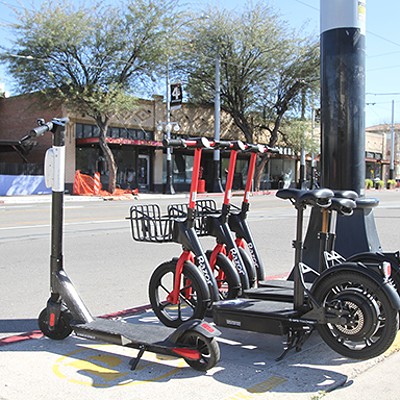The four-seater I am in is quiet at the moment. I quickly glance at the instrument panel before proceeding further. Slowly, I reach over and turn on the power--to my digital voice recorder. To my right is the real pilot of the plane, Juliana Rose Teal.
Teal is a petite, young-looking 41-year-old with shoulder-length, brown wavy hair and eyes that light up when she talks about aviation. She's the chairman of the local chapter of the Ninety-Nines, an international organization of licensed women pilots.
Teal is happy to sit with me in the cockpit and talk about flying and the Piper Cherokee. She co-owns the plane with three other pilots and says it's a 1970 low-wing with only 500 hours on the engine. Teal explains that low-wing means the wings are below the fuselage of the plane.
She also points out the six dials and gauges on the instrument panel, called the standard six-pack. Teal describes each one and also tells me about the flaps and throttle. She is a good teacher, but what stands out most is the ear-to-ear smile on her face. Her facial expression can only be described as pure joy.
"When I'm around airplanes, I can't stop smiling," she says.
Teal's flight path to becoming a pilot hit some turbulence in the beginning. Until 2001, she had a phobia of flying and was genuinely frightened when she boarded a plane. But on one flight from Tucson to California, her fear vanished.
"It was the first time I'd been on a plane and wasn't scared. I was looking out the window, and it was the most beautiful thing I've ever experienced. ... A thought came into my head: I wondered what it would be like to fly in a small plane."
Teal took her first flying lesson in January 2005 and got her private pilot's license in April 2007. She recently received her instrument-panel rating and plans to become a commercial pilot.
Teal was elected as chairman of the Tucson Ninety-Nines last summer. The organization provides networking, scholarship and education opportunities and preserves the history of women in aviation. Teal says the chapter has 62 members, including military, civilian and retired pilots.
Various fundraisers take place throughout the year, such as the pound rides coming up this Saturday, March 28, at Ryan Airfield (near Ajo Way and Valencia Road). You hop on a scale and get weighed; for 15 cents a pound, you take a 20-minute ride. (Visit the Ninety-Nines' Web site for more info.)
Teal says she has heard from many women who were inspired to learn to fly from attending the event. She encourages women who want to learn to fly to go for it.
"It's the most wonderful, satisfying experience you can have. You learn a lot about yourself, about self-sufficiency, and gain confidence in your abilities. ... If I can do it, I believe anyone can do it. Learning to fly is complicated, but it's doable."
This encouraging view is shared by another member of the Tucson Ninety-Nines, Roxanne Beckman. With more than 30 years of experience as a pilot, Beckman has seen the aviation industry change.
Beckman was the first woman hired at WestAir Commuter Airlines in Chico, Calif., in the early-'80s. She later became a flight instructor and was one of two women instructors at her school. Beckman says she occasionally had a student who didn't want to be taught by a woman, but her gender generally wasn't a problem.
Now she flies for NetJets, a private aviation company. Beckman says attitudes have changed, leading to a wider acceptance of women in the cockpit.
This is a far cry from the time of Helen Richey, the first female commercial pilot for Central Airlines in 1934. She worked 10 months before resigning after being barred from joining the union. She continued to fly, but she later died at the age of 37 from an apparent suicide. Reports indicate she was despondent over the lack of job opportunities.
From Richey to Beckman to Teal, women can fly with the same passion for aviation as men. Even so, the number of women pilots is surprisingly low. According to December 2007 data from the Federal Aviation Administration's Aeronautical Center, women pilots represent only 6 percent of the total U.S. pilot population. The reason for this is not clear.
It seems apparent that women aviators have come a long way, but still have miles to fly.





